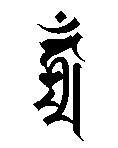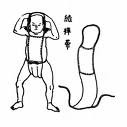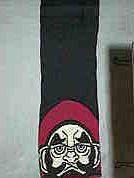[ . BACK to DARUMA TOP . ]Nihon no Kamisama 日本の神様 Under Construction.
Mostly in German for now.
Zahlen: Seitenzahlen, die im Sonderheft von Taiyoo, Winter 89 besprochen werden.
:::::::::::::::::::::::::::::::::::::::::::::::::::::::::::::::::::::::::::::::::::::::::::::::::::::
AenokotoFeldgottheit 56
Amaterasu OomikamiGottheit der Sage 14
Sonnen-Gottheit. Zentrale Figur des shintooistischen Pantheons. Ahnenfigur der kaiserlichen Familie. Im inneren Schrein (Naiku) in Ise verehrt.
[?Oomori (2), 168]
Amateru Kuniteru Hikohoagari no Mikoto Gottheit der Spiegel 154
Ame ko Koyane no MikotoBrachte die Amaterasu Oomikami dazu, wieder aus der Höhle zu kommen. Clangottheit des Fujiwara-Clans. Der Hauptschrein der Fujiwaras ist der große Schrein Kasuga Taisha in Nara. > Kasuga Shinkoo. [AOS:79]
Ame no tajikara no MikotoGottheit der Berge 53
Ame no Tomi no MikotoBrachte die Amaterasu Oomikami dazu, wieder aus der Höhle zu kommen. Clangottheit des Imbe-Clans. [AOS:79]
Ame no uzume no MikotoGottheit der Künste 152
Antoku TennooGottheit für Geburt 152
BinboogamiGötter der Armen der Edo-Zeit 148
Byakukoo shinIndische Gottheit, ev. Indra bzw. Taishakuten; symbolisiert die Reihneit des Schnees im Himalaya. Der Mönch Myooe machte sie zur Shintoo-Schutzgottheit der Kegon-Sekte. [AOS:50] > Zenmyoo Nyoshin.
En no Gyooja (gyoosha)Mensch-Gottheit 104
Futsunushi no Mikoto > Kasuga Shinkoo. Gottheit der Sage 29
g*
Gion ShinkooGottheit der Sage 19
h*
HachimanBuddhistische Manifestation (Honjibutsu) ist Dainichi Nyorai.
Dem Hachiman sind die meisten Schreine in Japan gewidmet. Fast jedes Dorf hat einen Hachimangu. Aber Hachiman ist keiner der traditionellen japanischen KAMI, er wird im Kojiki und im Nihon Shoki nicht erwähnt.
Hachiman hat sich warhscheinlich erstmals auf dem Berg Maki im Distrikt Usa (heute: Oita) in Kyuushuu manifestiert. Hachiman wird dabei auch Yahata oder Yawata gelesen. Er war vielleicht die Clan-Gottheit des Hata-Clans der chinesischen Immigranten in Kyuushuu. Es handelt sich um einen Clan der Kupfer-Bergleute, die besonders beim Erstellen des großen Buddha in Nara wirkten. Daher ist Hachiman die besondere Schutzgottheit des Tempels Toodaiji.
Hachiman soll auch als Helfer bei epidemischen Krankheiten gewirkt haben. Die wichtigsten Schreine befinden sich heute in Usa, Iwashimizu (Kyooto) und Kamakura. Auch Hachiman Daibosatsu (Großer Bodhisattva Hachiman) genannt. Kooboo Daishi verehrte diesen Daibosatsu besonders inbrünstig.
Iwashimizu Hachiman Mandala-Bilder (Miya Mandala) sind bekannt für detaillierte Landschaftsdar~stel~lungen. Der Schrein liegt am Fuße des Berges Otokoyama. [AOS:47,85,96f]
Besondere Figuren:Hachiman in Mönchsgewändern (Soogyoo Hachiman).Älteste Darstellung in einer Abbildung des Shingon-Tempel Jingooji, Kyooto.
Hachiman Dreiergruppen (Hachiman Sanzon)Mit zwei weiblichen Gottheiten:
Dabei wird Hachiman als Manifestation des Tennoo Oojin (Ojin) gedacht. Die eine Gottheit ist seine Mutter, Kaiserin Jinguu und die andere seine Haupt-Nebenfrau, Nakatsu-Hime. Die ältesten Abbildungen finden sich im Tempel Yakushiji und Tooji in Kyooto. [AOS:99]
Mit den Gottheiten Wakamiya und Takeshi-uchi Ookami:
auch als Sanskritzeichen-Mandala.
[AOS:103]
Hachiman Mandala der Gongen-Manifestationen (Hachiman Suijaku Mandala)Darstellung von Hachiman und mehreren Gottheit und Kinderfiguren (dooji); z.B. im Iwashimizu-Schrein.
Hachiman Mandala mit Sanskritzeichen (Hachiman Bonji Mandala)Hier zeigt sich die enge Verbindung zum esoterischen Buddhismus.
Hakone GongenBerggottheit in Hakone [AOS:57]
Hakusan Myoori GongenElfköpfiger Kannon.
[Oomori (2), 159]
Hayamikatama no Mikoto105
Honokagu Tsuchi no KamiGottheit der Töpfer 156
i*
Ichikishimahime no MikotoMeeresgottheit 61
Ideha no KamiGottheit der Berge 44
Wird in Haguro verehrt.
Imaki no KamiGottheit der Färber und Weber 157
Inari Kult (Inari Shinkoo)Gottheit der Sage 21, 72, 135
Iwakamutsukiri no MikotoGottheit des Essens 158
Izanagi no MikotoGottheit der Sage 12
Izanami no Mikoto Gottheit der Sage 12
Liegt in Kumano begraben. [Oomori (2), 158]
Izu-san, Sootoo-san Gongen(Shooichi Sengen Daibosatsu; Buddhistische Manifestation (Honjibutsu) = Tausendarmige Kannon) Berggottheit in Shizuoka. Später ev. Figuren des Ebisu. [AOS:57]
Izumo ShinkooVerehrte Gottheit:
>Susanoo no Mikoto.
Izumo TaishaÄltestes Beispiel des Großen Schreinbaus, letzte Restauration in 1744. [Hamajima, 98]
Größter Schrein Japans [Gateway, 444]
Hier wird Ookuninushi verehrt, auch in seiner Version als Daikoku.
J*
Jishu Kooya Myoojin ?jishuu
[Kato, 65]?
Gottheit des Kooya-Berges.
k*
Kamowake Ikazuchi no KamiGottheit der Sage 33
Kanayago no KamiGottheit des Eisens, der Schmiede 155
Kanmu TennooMensch-Gottheit 114
Kasuga Kult (Kasuga Shinkoo)Im Kasuga Taisha in Nara werden vier Gottheiten (Kasuga Gongen) verehrt. Manchmal wird noch ein fünfter Schrein, der Wakamiya, dazugezählt. Ein Wakamiya-Schrein ist im allgemeinen dem Kind einer Gottheit geweiht, hier aber der Berggipfelgottheit (shin~taizan) des Berges Mikasa, die hier am Fuße des Berges in einem "village shrine" verehrt wird. Die ?Honjibutsu-Mandala stellen oft den Wakamiya dar.
Die vier Gottheiten und ihre buddhistischen Manifestationen (Honji~butsu) in den vier Schreinen:«IP3,3»
Takemikazuchi no Mikoto in Ichi no Miya: Fukuu Kenjaku und Shaka Nyorai.
Futsunushi no Mikoto in Ni no Miya: Yakushi Nyorai.
Ame ko Koyane no Mikoto in San no Miya: Jizoo Bosatsu.
Himegami in Shi no Miya: Juuichimen Kannon.
Wakamiya: Monju Bosatsu.«IP»
Der Gott >Ame ko Koyane no Mikoto und seine Gattin Himegami aus Hiraoka brachte Amaterasu Oomikami dazu, wieder aus der Höhle zu kommen. Sie sind Clangottheiten des Fujiwara-Clans. Das seine buddhistische Manifestation (Honjibutsu) der Jizoo Bosatsu ist, wird der Berg Mikasa auf den Kasuga Mandalas (Kasuga Joodoo Mandala) auch oft als das Paradies im Westen dargestellt. Darunter in der Ebene zu Kasuga dachte man sich dann die Hölle, in die Jizoo steigt, um die Sünder zu retten.
Der Haupt~schrein der Fujiwaras ist der große Schrein Kasuga Taisha in Nara, in dem die Fujiwara-Clan-Gottheiten und lokalen Gottheiten verehrt werden. Am Fuße des Mikasa Berges gelegen. Als weitere Gottheiten werden dort verehrt: >Futsunushi no Mikoto von Katori (Chiba) und >Takemikazuchi no Mikoto von Kashima (Ibaraki), auch Kasuga Myoojin genannt. Er ritt auf einem Hirsch von Kashima nach dem Berg Mikasa; danach wurde das "Kasuga Deer Mandala" gemalt. Im Kasuga Park laufen heute noch unzählige Hirsche herum.
Das "Kasuga Gongen Reigen Ki" (The Kasuga Gongen Miracles) beschreibt die Geschichten um den Schrein. Ältestes Langrollen~bild von 1309, zeigt noch Szenen von traditionellen Shintoo-Tänzen (bugaku).
Der Kasuga Taisha hat eine enge Verbindung zum Tempel Koofukuji in Nara, dem Clan-Tempel des Fujiwara-Clans.
(29) [AOS:72,79]
Katsuragi no Mikumari, Uda no Mikumari, Tsuge no Mikumari Gottheiten für Regen und Wasser bzw. Irrigation. MIKUMARI = mizu kubari. [AOS:53]
Ketsumiko no ookamiGottheit der Berge 46
[?Oomori (2), 168]
Kibitsu no Mikotoauch: Kibitsuhiko no Mikoto
In der Gegend Kibitsu in Bitchu. Kämpft mit dem Dämon URA, besiegt ihn. Wird im Kibitsu Jinja in Okayama gefeiert. Auch eine Makse des Dämonen wird dort verehrt. Ein Metallkessel (okama) gibt Töne von sich, wenn erhitzt (der Dämon weint) : narukama no shinji. Eine Schamanin in weißen Gewändern (asome), sagt wahr aus diesem Kessel. Besondere Kessel-Halle "Okamaden". [Kanal 12, kiwameru II.]
Die Form des Schreins ist der Prototyp für den nach ihr benannten "Kibitsu zukuri"-Stil mit "hiyoku irimoya". In dieser Gegend gibt es auch viele alte Kofun-Grabstätten, z.B. Tsukuriyama Kofun, Koomori Kofun, Sensokuyama Kofun etc. [NHK, HAIKU 6/92].
Kitano TenjinVerehrung des Sugawara no Michizane im Kitano Schrein in Kyooto. [AOS:66,70]
Konohana no sakuyahimeGottheit der Berge 50
Konpira Kult (Konpira Shinkoo)Meeresgottheit 65
Kumano Kult (Kumano Shinkoo)[AOS:52,118ff] [?Hamada-3 176] [Oomori (2),] 158]
Am südlichen Teil der Kii-Halbinsel liegen die drei großen Schreine bzw. Berge von Kumano (Kumano Sanzan). Auch Mikumano genannt. [Kawaguchi, 67]
Im Hauptschrein (Hongu) (Kumano Nimasu Jinja)[Kawaguchi, 76] an der Mündung des Flusses wird
Ketsumikogami verehrt, eine Manifestation des >Susanoo no Mikoto. Buddhistische Manifestation ist Amida Nyorai.
Andere Legenden meinen, dort werde Susanoo oder Kukuri Hime no Mikoto oder Isotakeru no kami, Sohn des Susanoo, verehrt bzw. es gäbe dort keine eigene Gottheit (miyukiza).
Im Neuen Schrein (Shingu, Hayatama Schrein) im Oberlauf des Flusses wird
Hayatama no Ookami verehrt. Buddhistische Manifestation ist Yakushi Nyorai.
Im Nachi-Schrein (Nachi Jinja) am großen Wasserfall wird die Frau des Hayatama verehrt,
Fusumi (Kusubi, Musubi) no Ookami.
Wahrscheinlich von der Bedeutung "verbinden" (musubi) abgeleitet. [Kawaguchi, 68] Auch Nachi Gongen genannt. Ihre buddhistische Manifestation ist die Elfköpfige, Tausendarmige Kannon. (46)
Der Wasserfall als Gottheit selbst heißt auch "Fliegender Drachen"
Hiryuu Gongen.
Insgesamt werden in Kumano 12 Gottheiten (
Juuni Kumano Gongen) (Kumano Juunisha Gongen) [Kawaguchi, 76] verehrt. [Liste der Gottheiten [AOS:124] Die Pilgerfahrt dorthin heißt "Pilgerweg der Kumano-Ameisen" (Ari no Kumano Moode). [Kawaguchi, 69]
Ursprünglich ein Askeseberg der Yamabushi, nachdem En no Gyooja neben dem Kimpusan (Gottheit: Zao Gongen) und Yoshino auch dort Askese übte.
Seit der Heian-Zeit enge Verbindung mit dem Amida-Buddhismus, besonders der Tendai-Sekte des Tempels Miidera. Man glaubte, daß das Paradies des Westens direkt auf dem Kumano-Berg sei.
Auch der Priester Saigyoo (Langrollenbild: Saigyoo Monogatari Emaki) und der Heilige Ippen (Langrollenbild: Ippen Shoonin Eden) waren hier. Verschiedene Tennoos, besonders Goshirakawa, machten zahlreiche Pilgerfahrten zu den Kumano Schreinen (über 200 Kilometer von Kyooto entfernt). Dabei wurden Gedichte geschrieben (Kumano Gaishi) und besondere Rituale beachtet.
Es gibt verschiedene Mandalas über den Kumano-Komplex: Mandalas der buddhistischen Manifestationen (Honjibutsu Mandala), der Gongen-Manifestationen (Suijaku Mandala), Schrein Mandalas (Miya Mandala) und Langbildrollen.
Das Klare Wasser des Wasserfallbeckens galt seit alter Zeit als heilkräftig und lebensverlängernd. Daher ernannte es Shirakawa Tennoo zum Heiligen Ort. (1090). Er wurde selbst 77 Jahre alt. [Kawaguchi, 68]
Der Schrein spende Glück für zwei Generationen (nise goriyaku). [Kawaguchi, 69]
Er gehört als Askese-Übungsort (shgendoojoo) zur Tendai-Sekte. Die Pilgerfahrt ging von Kumanoo über den ?daikinsan zum Yoshino Gongen. Die umgekehrte Pilgerfahrt (gyaku no mineiri) gab es auch. [Kawaguchi, 70]
Der Bote der Kumano-Gottheit ist eine Übergroße Krähe (yata garasu). Sie befindet sich auf dem großen Sigel von Kumano (Kumano Gooo Hooin). (gooo - Rinderkönig).
Die Priester von Kumano benutzten die Frauen und Töchter der Gläubigen als ?miko und zu anderen Zwecken. Man nannte sie "Sängerinnen-Nonnen" (utabikuni, Kumano bikuni). Diese Sängerinnen-Tradition besteht noch heute.
Komori Myoojin[AOS:95]
m*
Matara-jin, Sekizan MyoojinUrsprünglich taoistische chinesische Gottheiten. Von Tendai-Mönch Ennin zum Tempel Hiei gebracht. Schutzgottheiten des Berges Hiei. [AOS:75
Matsunooo Kult (Matsunooo Shinkoo)Matsunooo-Glaube [AOS:66]
Meiji TennooMensch-Gottheit 122
Mikomori MyoojinGöttin für Kinderschutz) [AOS:53]
Mikumari no Kami und Yamaguchi no KamiGottheit der Berge und Ebenen [AOS:53]
Mizu HanomeWassergöttin [AOS:52]
n*
Nagakawa Kult (Nakagawa Shinkoo)Gottheit der Sage 19
NakatsuhimeTeil der >Hachiman Dreiergruppe [AOS:47]
Ninigi no MikotoEnkel der Amaterasu Oomikami.
Ihm ist der Schrein Kirishima in Kyuushuu gewidmet. [Immoos, 29]
Niu Myoojin, Niutsu Hime MyoojinSchutzgottheit des Berges Kooya. Zeigte sich damals dem Kooboo Daishi. NIU bezieht sich oft auf Berge, in denen Quecksilber abgebaut wurde. Vielleicht war sie die Schutzgottheit der Bergarbeiter. [AOS:71] [check? Oomori (2), 155]
Obie MyoojinGottheit der Berge 54
Oojin TennooMensch-Gottheit 112
>Hachiman
Ookuninushi no KamiGottheit der Sage 24
Auch Ooanamuchi no Mikoto genannt.
Auch als Daikokusama verehrt. Gott der Ärzte, der Medizin, der Onsen und der Sake-Herstellung. Wird im Yuudonoyama Jinja verehrt. [DEWA 41]
Oomononushi no KamiGottheit der Reisweins 160
Oomononushi no MikotoMeeresgottheit 64
OshirasamaWird auf dem Osoresan verehrt.
Memyo Bosatsu and O-Shirasama ... Silk Production in Japan
Oowatatsumi no MikotoMeeresgottheit 66; [AOS:56]
Ooyamakui no KamiGottheit des Reisweins 161;
Schutzgottheit des Hiei-Berges [AOS:48]
Ooyamatsumi no Kami (ooyamazumi)Gottheit der Berge 44, 158
Auf dem Haguro-Berg verehrt.
[Oomori (2), 159, 168]: Auch Hakusan.
Ooyamazumi no Kami (Ooyamatsumi), Nozuchi no KamiGottheit des Tabaks 158
RinjooinGottheit der Manjuu-Kuchen 162
s*
Sakadoki no KamiGottheit des Reisweins 160
Sannoo Kult (Sannoo Shinkoo)[AOS:104ff] [Kato 65]
Hie Sanno Myoojin.
Kult des Berggottes Sannoo, der ursprünglichen Gottheit des Berges Hiei und Hachiooji in Kyooto. Dengyoo Daishi, der Gründer des Tendai-Tempels auf diesem Berg, ließ besondere Rituale zur Besänftigung dieser Gottheit ausführen.
Hauptschrein ist der Hiei Schrein (Hiyoshi Schrein) am östlichen Fuße des Hiei-Berges, mit Blick auf den Biwasee. Der östliche Schrein ist der lokalen Gottheit Oyamagui no Mikoto gewidmet, der westliche Schrein dem Inamuchi no Mikoto, einer Gottheit vom Berg Miwa in Yamato (Nara). Zusammen mit weiteren fünf bilden sie die Sieben oberen Hauptschreine des Sannoo-Kultes. Daneben gibt es noch sieben mittlere und sieben untere, insgesamt also 21 Haupt~schreine. .
Liste der Kami (wilde und ruhige Seele) und ihrer buddhistischen Manifestationen:
Oyamagui no Mikoto
(nigimitama) Yakushi Nyorai
Tamayorihime no Mikoto
(nigimitama) Jizoo Bosatsu
Oyamagui no Mikoto
(aramitama) Tausendarmige Kannon
Tamayorihime no Mikoto
(aramitama) Fugen Bosatsu
Onamuchi no Mikoto Shaka Nyorai
Tagorihime no Mikoto Amida Nyorai
Shirayamahime no Mikoto Elfköpfige Kannon
(Siehe ausführliche Listen auf [AOS:106. 112])
Daneben gab es noch weiter Buddhistische Tempel und Unterschreine in diesem Berggebiet, nämlich 108 innere und 108 äußere Schreine.
Die Seele einer Gottheit, mitama, kann geteilt sein (wilde Seele (aramitama), ruhige Seele (nigimitama) und weitere Teile) und so in vielen Schreinen im ganzen Land verehrt werden.
Sannoo-Tempelfest früher am Tag vor und nach dem Tag des Affen im vierten Mondmonat, heute am 12. bis 15. April.
Besondere Formen:Sannoo Mandala der Gongen-Manifestationen (Sannoo Suijaku Mandala)Stellen die KAMI der sieben oberen Schreine und ihre buddhistischen Manifestationen (Honjibutsu) dar.
Sannoo Bonji MandalaSannoo Schrein-Mandala (Sannoo Miya Mandala)Die Landschaftsgestaltung läßt genau die Formen der damaligen Architektur erkennen.
Sanjuusan BanshinNach der Lotus-Sutra Schutzgottheiten für jeden Tag des Monats. Später von Nichiren-Sekte übernommen. [AOS:66]
Seiryuu GongenBuddhistische Manifestation (Honjibutsu) ist Nyoirin Kannon im Tempel Daigoji. Gottheit aus China vom Berg Ch'ing-lung. Von Kooboo Daishi als Schutzgottheit der Shingon-Sekte mit nach Japan gebracht. Ikonografie: Schöne Frau in Kleidern der T'ang Zeit. Trägt ein magisches Juwel. Krone mit Goldjuwelen [AOS:61,70]
Shichi Fukujin (7 Glücksgötter)124
Shiragi Myoojin, Shinra MyoojinUrsprünglich chinesische taoistische Gottheit. Schutzgottheit des Tempels Mii-dera am Biwa-See. [AOS:60]
Shirayamahime no MikotoGottheit der Berge 48
Buddhistische Manifestation ist Juuichimen Kannon.
>Sannoo Kult.
ShugoshinSchutzgottheiten 75
Sokotsutsu no oomikotoMeeresgottheit 62
Sukunahikona no KamiGottheit der Medizin 156
Sumiyoshi Ookami[AOS:70]
Sumiyoshi Myoojin. Schrein in Osaka.
Gottheit der Poesie. [Awakawa]
Susanoo no MikotoGottheit der Sage 18
Wird in den Großen Schreinen von Kumano, Izumo, ?Nagakawa und Yasaka verehrt.
Bruder der Sonnengottheit Amaterasu. Lehrte die Menschen den Schiffsbau und die Forstwirtschaft. [AOS:118]
Suwa ShinkooGottheit der Sage 27
t*
Ta no KamiFeldgottheiten 56
Tagitsuhime no MikotoMeeresgottheit 61
Tagorihime no MikotoMeeresgottheit 61
Buddhistische Manifestation ist Amida Nyorai.
>Sannoo Kult.
Taira no MasakadoMensch-Gottheit 115
Tajimamori no MikotoGottheit der süssen Kuchen 162
Takeiwatatsuno no Mikoto105
Takemikazuchi no MikotoAuch Kasuga Myoojin genannt. Wahrscheinlich Kriesgott aus dem Norden. Er ritt auf einem Hirsch von Kashima (Ibaraki) bis nach Nara zum Berg Mikasa. (Kasuga Deer Mandala)
> Kasuga Shinkoo. 28, [AOS:80]
Takeminakata no KamiGottheit der Sage 26
TamashiSeelen 67
Tamayorihime no MikotoGottheit der Sage 32; Beschützerin der Kinder [AOS:53]
Buddhistische Manifestation der ruhigen Seele: Jizoo Bosatsu.
Buddhistische Manifestation der wilden Seele: Fugen Bosatsu.
>Sannoo Kult.
Wird in Haguro verehrt.
Tatsuta MyoojinWindgottheit. Schutzgottheit des Tatsuta-Flusses in Nara. [AOS:54,65]
Temma Daijizai TenjinSugawara no Michizane, Mensch-Gottheit. 116
Tooshoo DaigongenVerehrt im Tooshooguu. Mensch-Gottheit. Tokugawa Ieyasu, 120 [AOS:78]
Toyokuni DaimyoojinMensch-Gottheit. Toyotomi Hideyoshi. Verehrt im Hookoku Schrein in Kyooto, wo er begraben liegt. [AOS:78]
Tsukiyomi no KamiGottheit der Berge 44
Wird in Gassan Jinja verehrt. Er tötete Ukemochi no Mikoto, weil der die Aufbewahrung des Getreides nicht sauber genug vornahm. Danach gab es Streit zwischen Tsukiyomi und Amaterasu und Tag und Nacht trennten sich. (Verehrung von Amaterasu (Sonne) in Ise und Tsukiyomi (Mond) in Gassan.) Er wurde zur Verwaltung von "Yoru no Osukuni" bestellt, dem Land der Unterwelt (yomi). Er wird verehrt als Gottheit der Landwirtschaft und Schützer der Lebensmittel.
[DEWA 39]
Uga no mitama no KamiGottheit der Sage 21
Wird im Dewa Jinja verehrt. [DEWA 37]
Uhoo doojiGottheit der Berge 52
Ukemochi no MikotoAlter Gott der fünf Getreidesorten. Wurde von Tsukiyomi no Mikoto getötet, weil der die Aufbewahrung des Getreides nicht sauber genug vornahm. Danach gab es Streit zwischen Tsukiyomi und Amaterasu. [DEWA 39]
Yamaoo Kult (Yamaoo Shinkoo)Gottheit der Berge 54
Yamato Takeru no MikotoGottheit der Sage 34
Yanagimoto MyoojinWeidenbaum-Gottheit. Im Mönchsgewand. [AOS:66]
Zenmyoo Nyoshin (Zemmyoo)Lady Shan miao auf Chinesisch. Beschreibung ihrer Geschichte und der des Mönches Myooe im Kegon Engi. [AOS:59]. > Byakukoo Shin.
:::::::::::::::::::::::::::::::::::::::::::::::::::::::::::::::::::::::::::::::::::::::::::::::::::::
More about Japanese Deitieshttp://fudosama.blogspot.com/Literature see here:http://darumasan.blogspot.com/2004/12/literature.html:::::::::::::::::::::::::::::::::::::::::::::::::::::::::::::::::::::::::::::::::::::::::::::::::::::
Alphabetical Index of the Daruma Museum






































